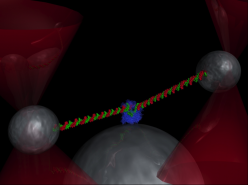Want to silence a gene? Pull here

(PhysOrg.com) -- Simply stretching DNA can silence a gene, scientists at the UA have discovered. The finding could point to a previously unknown gene control mechanism.
In order for living organisms to function properly, the activity of genes contained within the DNA must be precisely regulated.
Many ways in which organisms achieve this are already known to science, but a team led by Koen Visscher, an associate professor in the University of Arizona's department of physics, found one more way in which cells may control gene expression. They published their results in the Biophysical Journal.
"We are able to turn off gene expression just by stretching the DNA," said Visscher, who holds joint appointments in the departments of molecular and cellular biology, the College of Optical Sciences and the UA's BIO5 Institute. "This discovery has important implications for our understanding of how cells operate at the molecular level."
In order to activate a gene and read out its information, a cell must activate certain components of its biochemical machinery. First, an enzyme called RNA Polymerase must latch onto a specific binding site on the DNA and unwind the two strands that make up the double helix. The enzyme then travels along the stretch of DNA, reading out the information and making a copy in the form of an RNA molecule.
Visscher and his co-workers, Gary Skinner and Bennett Kalafut, took advantage of so-called optical tweezers to manipulate and move around the molecular players necessary for the process of gene activation and study how they interact.
At the heart of the optical tweezers apparatus is an infrared laser capable of trapping tiny particles and holding them in place. Visscher and his co-workers attach a single DNA molecule to plastic beads so small that tens of them in a row would barely reach across a human hair.
"We trap one of those beads in our optical tweezers," Visscher explained. "Then we go in with a second trapped bead carrying an antibody capable of attaching to the DNA and run it into the first bead. The idea is to try and catch the loose end of the DNA. It's like fishing for DNA."
This fishing expedition can take a long time. Because the DNA is too small to see even with a microscope, the researchers use the optical tweezers to slightly tug on one bead and watch whether the other moves in response.
"If it does, we know we hooked the DNA," Visscher said.
Once both beads connected by the strand of DNA are trapped, the scientists make one of the beads oscillate back and forth. The DNA transmits the movement causing the bead on the other end to oscillate as well.
To measure the interaction between the DNA and the RNA Polymerase molecule, a third bead comes into play: Studded with a few RNA Polymerase molecules and attached to a microscope slide, it is placed underneath the outstretched DNA molecule, which contains an RNA Polymerase binding site, a specific code sequence that the enzyme recognizes and binds to.
"We slowly lower the DNA onto the enzyme," Visscher said. "Once it latches onto the DNA, it inhibits the transduction of force between the beads. It's like two children pulling back and forth on an elastic band until a frustrated parent grabs it in the middle and puts an end to the horseplay. In our case, the RNA Polymerase has the same effect: The DNA strand can no longer transmit the oscillations from the first bead to the second, causing it to stop moving. That is how we know if the polymerase has bound to the DNA."
The discovery came when the researchers pulled on the two beads holding the DNA, gradually increasing the tension. At some point, the gene was no longer read.
"As we increase the tension, we see that the enzyme finds it harder and harder to latch on," Visscher said, "to the point where it still binds but falls off almost immediately."
The force applied to the DNA strand ranges from 1 piconewton to 12 piconewton, about 50,000 times weaker than the weight of a grain of salt.
"If we apply too much force, we alter the structure of the DNA," Visscher said. "If we change the structure of the DNA, all bets are off as far as the interaction with the protein goes. We want to be far away from that."
According to Visscher, the controlled stretching of DNA could pave the way for new applications that require precise control over gene expression, such as the "lab on a chip." Analogous to microprocessors, those chips are used to miniaturize biochemical processes, for example in screening for new drug candidate molecules.
"There are a lot of ways to biochemically control the activity of genes on those chips," Visscher said, "but we believe there is another way: You can do it by force. Picture a chip with DNA molecules attached to it. If you attach a magnetic bead to the end of certain DNAs and place an electromagnet above that chip, you could switch certain genes on or off, simply by stretching or relaxing the DNA."
What about nature? Is it possible that organisms use DNA stretching as a way to control their gene expression?
"We don't know that yet for sure," Visscher said. "But if one looks at how DNA is packed in a cell's nucleus, one finds that there is a lot of stretching and twisting going on, so it's possible. We do know of one case in the literature in which DNA is attached to the cell membrane, causing the DNA to be under tension certain regions. Interestingly, genes are not expressed when they're in those regions. We encourage scientists in the molecular life sciences fields to keep an eye out whether this mechanism could explain gene activity patterns that can't be explained with biochemistry alone."
Provided by University of Arizona
















